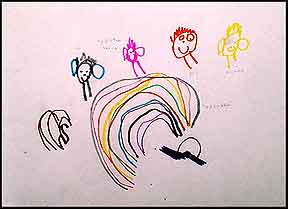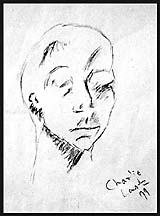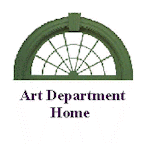|

|
|

|

|
The drawing on the left is a self portrait done by Charlie Lantz, grade 6. He made it as part of his third lesson taught in Field Teaching by Judy Rohrer, April, 1999. He had practiced both contour drawing and gesture drawing in the first two lessons. This drawing was done by a combination of gesture and contour methods while looking in a mirror. A self-portrait of a famous artist was discussed after this drawing was done. |
|
ART FOR CHILDREN, Art 309, ©
Marvin Bartel, Instructor
Goshen College Art Department, updated 10-02
Goshen College students may make a copy for their own use. Others need
to E-mail marvinpb@goshen.edu for permission to publish any part of this
document.
Check list of things to do. Please see current Calendar for a dates for this schedule.
Review Planning Art Lessons , for a guide in planning. Study Sources of Art Lesson Ideas . You are encouraged to consult with other persons in our class. Thursday/Friday, (see calendar) , bring the plans for your three sessions. You will discuss your lesson plans with others teaching similar aged children. You will carefully assess each other's plans, offering each other alternatives and ways to change their lessons. In a few cases, you may decide to totally change your plan and do lessons similar to another person in your group. If you do, you can learn directly from each other's experience. Tape record your sessions with the child. This is required for this assignment. You are required to listen to your own tape before completing the self-evaluation that you do after the lesson. The instructor will not listen to the whole tape, but you will be asked to bring the tape to class and play a short sample to the class. You are asked to cue the tape to any short sample that you are willing to share with the class. Teach one or more complete art lesson(s) as described in Planning Art Lessons during the three sessions. One lesson may be continued from session to session, or you may teach up to three lessons, but each lesson should contain all the parts of a lesson including ending connections with the world of art and connections between their art and everyday life. Begin teaching the lessons as soon as possible after you have had your pre-teaching discussions. Check list of what to include in the three sessionsü Set up and explain need for tape recorder (explain that you are learning how to teach and need the tape to practice). Please do not bring defective equipment to this session. Test it before using it. Be sure it works. Listen to actual samples of a recording you make in a similar environment. Be sure you know its limitations. Extra batteries or a power supply and tape are part of your responsibility. ü Interview your student about past artwork. Museum and gallery visits. Favorites. See what you can learn from the child. Assemble materials ü Before teaching, do all the activities yourself so you know for sure what you need and how it works, but do not show the child your work before the child has a chance to do it. Preliminary Practice Time ü Your student needs time to learn material, process, observation, imagination list, motivational activities, discuss topics (content) (subject matter), objectives, concepts, principles, elements, questions to answer visually, new vocabulary, and so on. Make connections to surroundings, to ordinary experiences, and/or to real feelings. Creative Production of Main Project ü Allow sufficient time or continue from session to session on this. When continuing from session to session, take time to review the motivation and preparation activities from prior sessions. Transfer of learning is rare unless we help make connections. Discussionü What was learned and accomplished in the practice and in the main project? ü Review vocabulary. ü Review connections to ordinary experiences, surroundings, and/or feelings. Art History or Multicultural Connections ü Relate a significant artist and/or art by drawing out the similarities to their own objectives, processes, subjects, and so on.
ü
You may want to use the color laser
(used to print your montage) to make a "take home" reproduction.
ü As a teaching aide, you may want to make a form on which the child can write name of artist and descriptive terms (vocabulary).
|

|
I Am Playing Tennis With My Father , boy, age 9, this is drawing based on actual memory experience. The motivational question was, "What is something you did together with somebody else recently?" |
|
Art for Children
Home
All rights reserved. This page © Marvin Bartel, instructor, 2000
Art for Children
class members may print this for their own use. Others must e-mail marvinpb@goshen.edu
for permission to reproduce or publish.

|